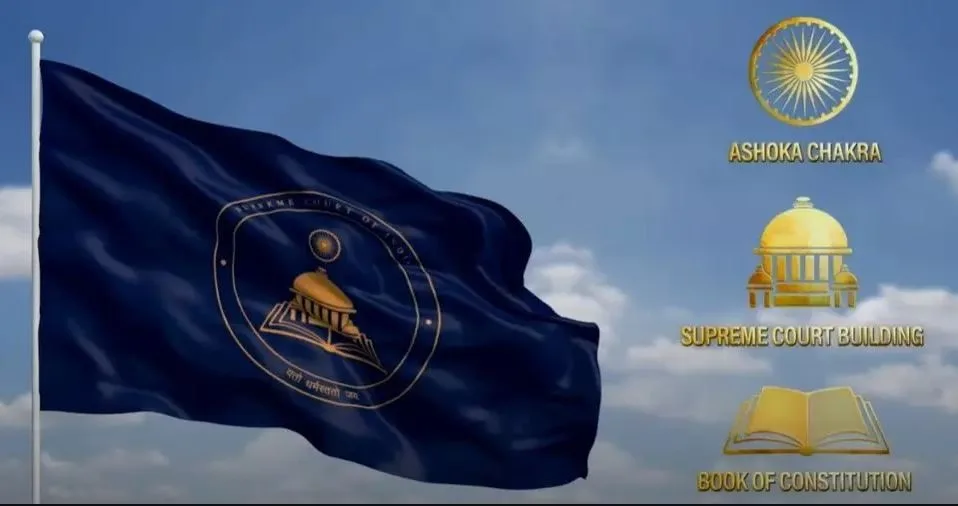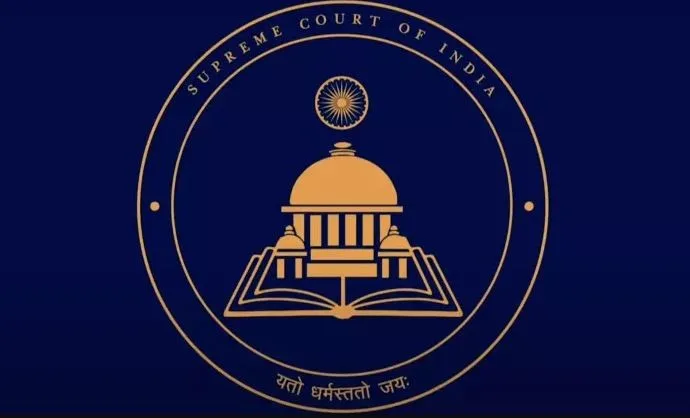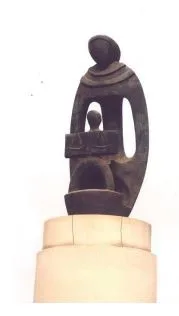Syllabus: GS2/Polity
Context
- President Droupadi Murmu unveiled the new flag and insignia of the Supreme Court to mark the 75th year of its establishment.
About
- The flag features the Ashoka Chakra, the Supreme Court building and the book of the Constitution of India.
- The new Supreme Court flag is blue in colour. The insignia has ‘Supreme Court of India’ and ‘Yato Dharmastato Jayah’ (in Devanagari script) inscribed on it.
- The phrase “Yato Dharmastato Jayah” is a Sanskrit expression that translates to “Where there is Dharma, there is victory” or “Victory lies where Dharma (righteousness) prevails.”
- Ashok Chakra represents the dharmachakra or “wheel of the law”. This symbol is inspired by the Sarnath Lion Capital, which was created by the 3rd-century BC Mauryan Emperor Ashoka.


Establishment of Supreme Court (SC) of India
- Article 124 of the Constitution states that “There shall be a Supreme Court of India.”
- On 28 January 1950, two days after India became a Sovereign Democratic Republic, the Supreme Court was inaugurated.
- The first President of India Dr. Rajendra Prasad inaugurated the present building of the Supreme Court of India on 4 August 1958.
- The original Constitution of 1950 envisaged a Supreme Court with a Chief Justice and 7 puisne Judges – leaving it to Parliament to increase this number.
- Considering the increase in workload, Parliament increased the number of Judges from 8 in 1950 to 11 in 1956, 14 in 1960, 18 in 1978, 26 in 1986, 31 in 2009 and 34 in 2019 (current strength).
- The Supreme Court Officers and Servants (Conditions of Service and Conduct) Rules, 1961 contains the rules with respect to the conditions of service and conduct of the staff attached to the Supreme Court of India.
Mother and Child Sculpture
- A black bronze sculpture of 210 centimeter height was installed in lawn of the Supreme Court in 1978.
- It portrays Mother India in the form of the figure of a lady.
- The lady is sheltering the young Republic of India represented by the symbol of a child, who is upholding the laws of land symbolically shown in the form of an open book.
- In the book, a balance is shown, which represents dispensation of equal justice to all. The sculpture was made by the renowned artist Shri Chintamoni Kar.

Brief on Judiciary in India
- The Supreme court is the highest court in India, with the authority to interpret the Constitution, adjudicate disputes between states and the center, and oversee the legality of laws and government actions.
- Each state or group of states has a High Court, which handles appeals from lower courts and issues related to state-level legal matters.
- District Courts handle civil and criminal cases at the district level, and various specialized courts such as family courts, consumer courts, and labor courts.
- Each branch operates independently but is designed to work in harmony with the others, providing a system of checks and balances to ensure fair governance and adherence to the Constitution.
Key Functions of the Supreme Court of India:
- Judicial Review: It reviews the constitutionality of laws and executive actions. If a law or action is found to violate the Constitution, the Court can strike it down.
- Original Jurisdiction: It has the authority to hear certain types of cases directly, including disputes between states or between the central government and states. This is called original jurisdiction.
- Appellate Jurisdiction: It hears appeals from lower courts and tribunals. This includes civil, criminal, and constitutional matters.
- The Supreme Court can overturn or modify decisions made by lower courts.
- Constitutional Interpretation: It interprets the provisions of the Constitution.
- This function is crucial for clarifying the meaning and application of constitutional principles.
- Protection of Fundamental Rights: It ensures the protection of fundamental rights guaranteed by the Constitution.
- Advisory Jurisdiction: The President of India can seek the Court’s opinion on legal or constitutional questions.
- While the Court’s advice is not binding, it is highly influential.
- Judicial Administration: It oversees the functioning of lower courts and provides guidelines for their operation. It also plays a role in the appointment and transfer of judges.
- Public Interest Litigation (PIL): The Court entertains PILs, allowing individuals or groups to seek judicial redress for issues affecting the public at large.
Source: PIB
Previous article
News In Short – 31-08-2024
Next article
India-Pakistan Relations